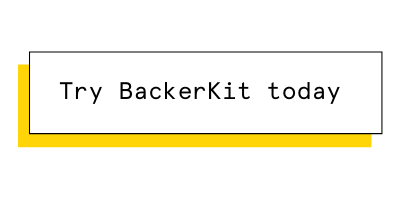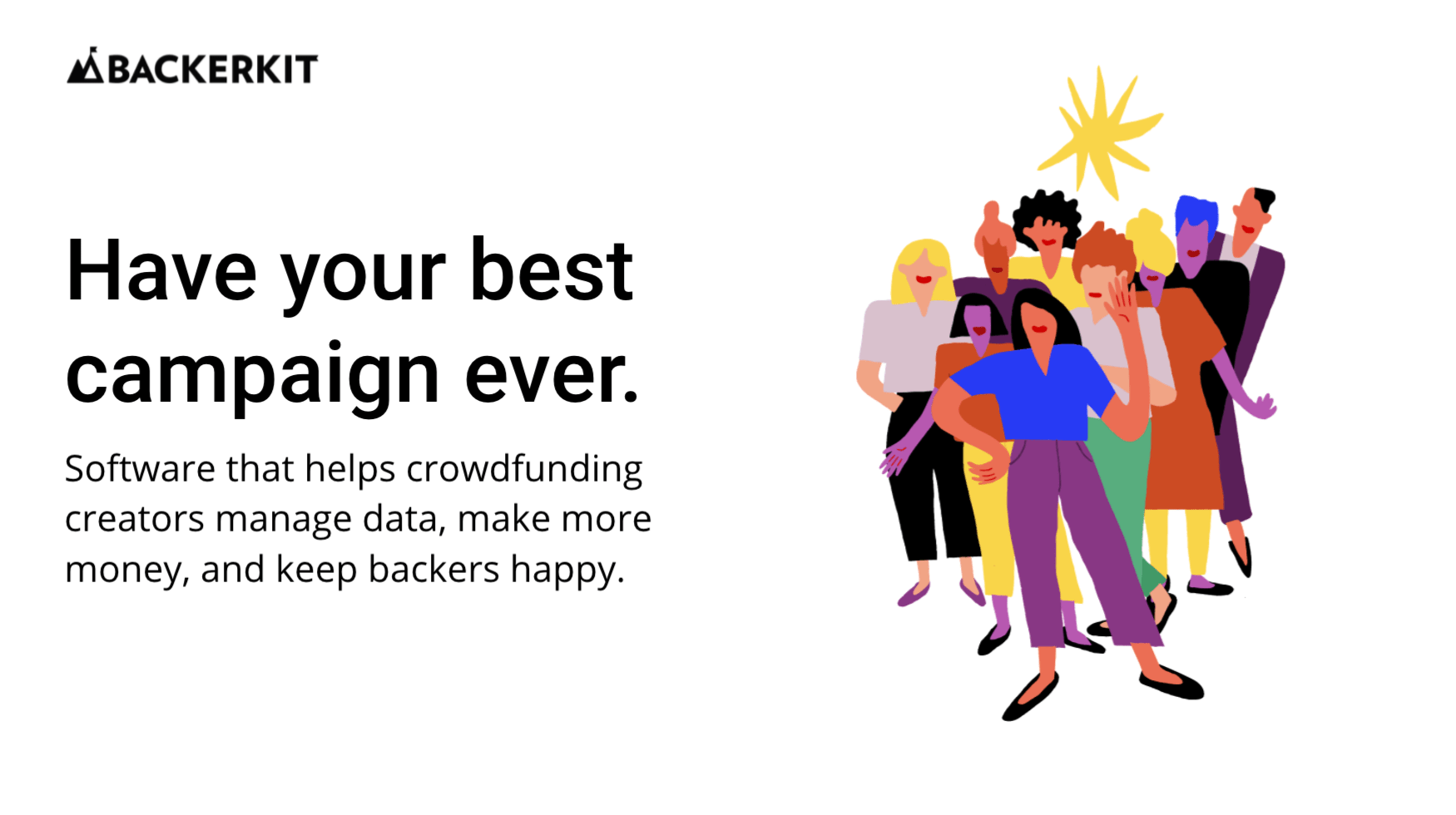Crowdfunding is a journey that we probably all hope will be as simple as this:
Step 1: Have an excellent idea for a crowdfunding project.
Step 2: Launch your project on Kickstarter or Indiegogo.
Step 3: Get funded.
Step 4: Send out rewards to backers.
While the steps listed above are all features of a successful campaign, there are obviously several other critical stages, challenges, and logistical issues that you’ll need to contend with to get you from “excellent idea” to “delivering rewards.” Think about it: You need backers. How are you going to get them? And what about fulfillment? Your project comes to life on Kickstarter or Indiegogo, but there are also tools and resources outside of those platforms that will help you tackle your campaign to-do list, simplify your overall crowdfunding experience, and raise more money.
So what do you realistically have to do to get your project off the ground and funded?
Crowdfunding can be overwhelming. Connor Alexander, the creator of the tabletop RPG Coyote & Crow, was a prolific backer before launching his own project but was stunned by how complex crowdfunding was as a creator.
“When you first get involved in crowdfunding, and you’re dealing with Kickstarter, there’s already this feeling of vertigo,” Alexander says. “It’s a bigger world than you’d realized.”
There’s a lot of pre-launch preparation you’ll have to do. Of course, you’ll have to develop your idea, turn it into a prototype (if you’re designing a physical product and not something like a theater experience), and then test that prototype and validate your idea. While you’re working on all that, you’ll simultaneously be devoting time to building a community of people who will be excited to back you when you launch.
Once all of that foundational work is in motion, there are a whole new set of tasks you’ll have to complete to run a successful campaign. Your to-do list looks something like this:
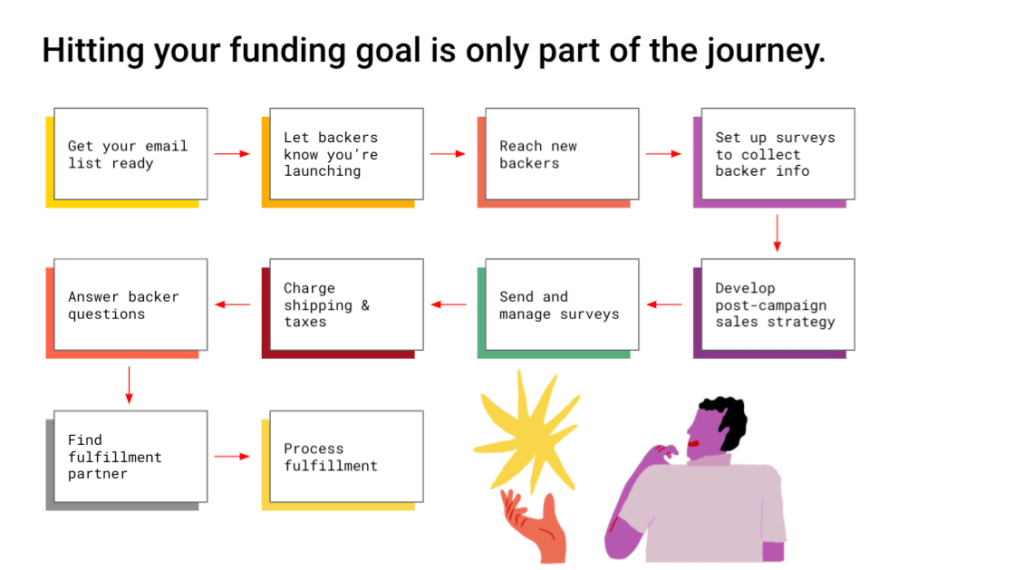
It’s a lot to manage, but you don’t have to do it alone.
What is BackerKit?
BackerKit is a software company that creates tools to help crowdfunding creators raise additional funds, reach new backers, and deliver the right rewards to the right places. Over the years, we’ve helped creators survey 15.5 million backers and raise $331 million. We’ve also worked with more than 10,000 crowdfunding projects, including Dispel Dice, OYO NOVA Gym, and Frosthaven.
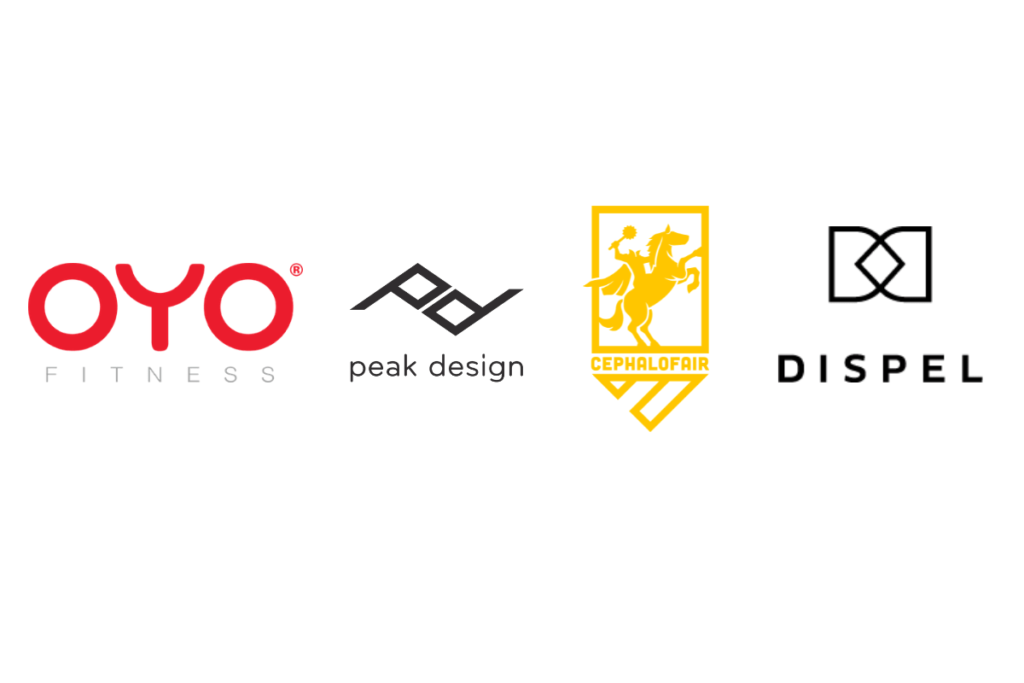
We take everything that we learn from working with the most successful Kickstarter and Indiegogo creators and incorporate those lessons into our core products: BackerKit Launch, BackerKit Marketing, and BackerKit Pledge Manager. Each of these three tools will help you make your way through your crowdfunding journey and manage many of the common challenges creators experience.
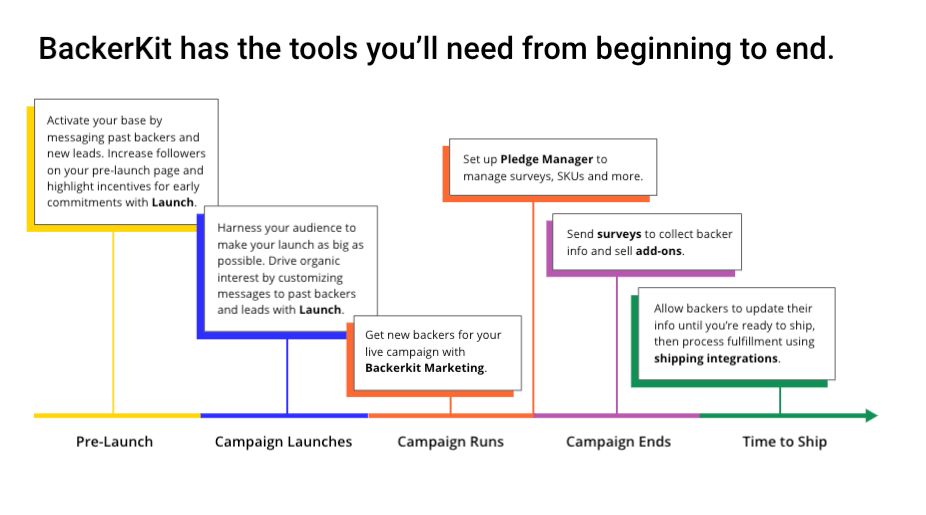
Challenge #1: Getting pledges in the critical first 48 hours of your campaign
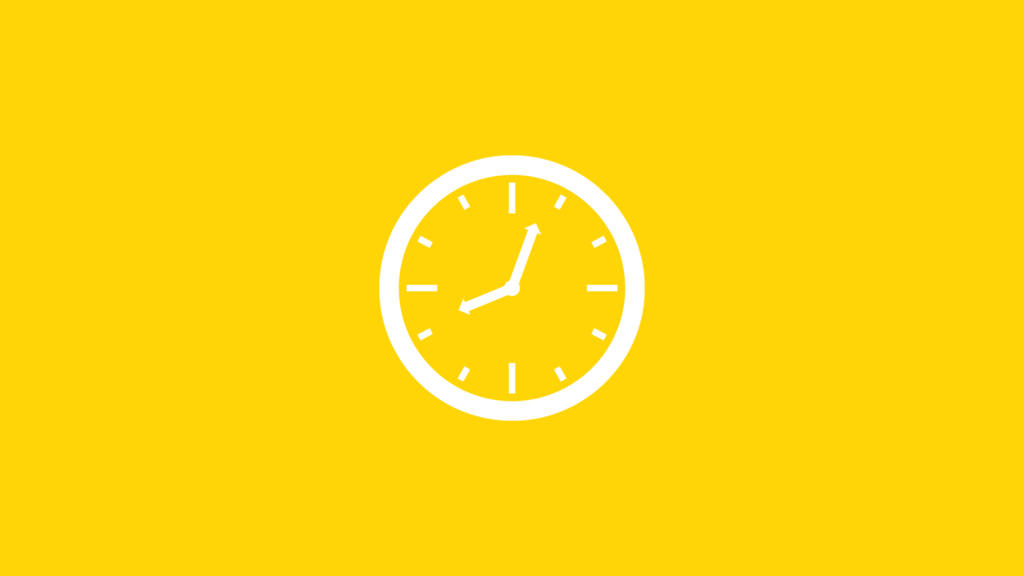
Kickstarter and Indiegogo don’t instantaneously drive backers to your project once it’s live. You have to bring those initial backers to your campaign page. To get that first wave of support, you’ll need an email list of supporters who are not only prepared to pledge but who can make those pledges within the first 48 hours. If your campaign performs well early on, the crowdfunding platform’s algorithm will reward you with higher placement in search results.
“If you’re able to get in the top 20 campaigns [on Kickstarter], people naturally and organically are going to be finding your campaign. Not just on that top 20 trending [list], but you’re also going to be ranking highly in different categories,” says Chris Livingston, Gravel co-founder and five-time successful Kickstarter creator.
Leverage your existing audience and get early pledges with BackerKit Launch
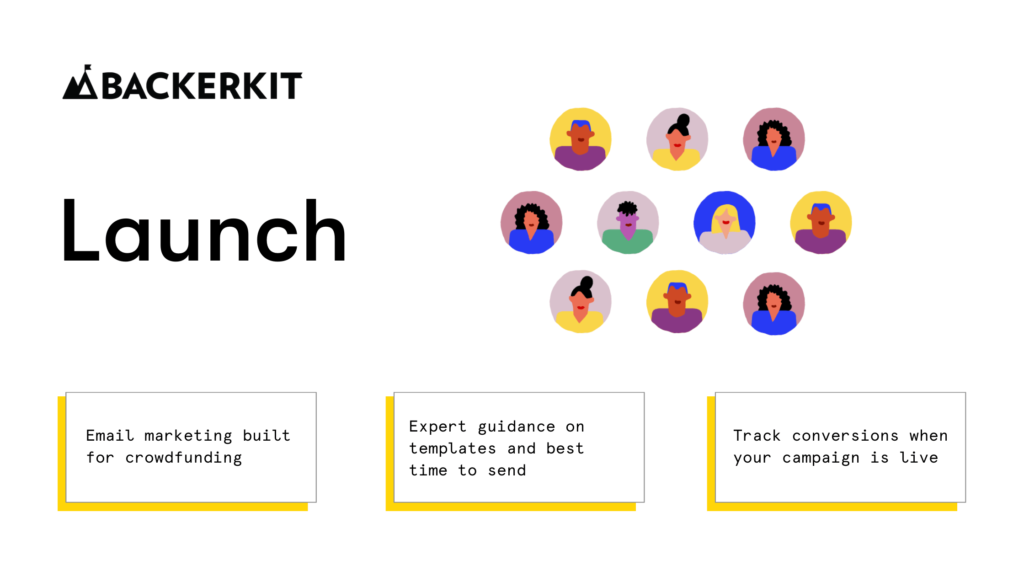
BackerKit Launch helps you get those early pledges and activate your community. It’s an email marketing and analytics tool specifically designed for crowdfunding. Like a standard email marketing platform, you can collect email addresses (or import an existing email list) through Launch and communicate with your audience. But it also allows you to take a more data-driven approach to your launch, providing you with insights you can’t get from other email tools. Here’s how it works:
1. Build your email list
You can’t expect Kickstarter or Indiegogo to deliver backers to your campaign page organically. You have to bring those backers to the party. One way of doing this is by growing your community and building your email list. With Launch, you can create a landing page to collect email addresses and start doing that community-building work early on. It’s free to start using Launch landing pages. And once you’re ready to start sending out emails through Launch, you’ll have all of that data right there in one convenient place, so you’ll be primed to begin promoting your campaign.
2. Test the strength of your email list
Before your campaign is live, you can import your email list into Launch to test its strength. You’ll see who from that list has already backed crowdfunding projects and is, therefore, more likely to support your project. Armed with this data, you’ll know if you have to spend more time building or educating your community or if you’re on track to have a strong showing on day one.
Sign up to check out BackerKit Launch and test the strength of your email list for free!
3. Deliver the right message at the right time
Anyone can use Launch to mobilize supporters and create personalized email marketing messages. Launch connects directly to Kickstarter and Indiegogo, so you’ll get real-time pledge information once your project is live. This means you’ll be able to track conversion rates and see who from your email list has already contributed and who hasn’t. You can segment — or group — the people who haven’t pledged yet together and then tailor messages to that audience to encourage them to support you. This kind of personalization is the key to driving conversions.
4. Serial crowdfunders can eliminate launch day surprises
If you’re a creator who has run multiple successful Indiegogo or Kickstarter campaigns, you can import past projects into Launch and get insights into your previous backers’ pledge behavior. By looking at Launch data, like how much money repeat backers contributed to your other campaigns and when they pledged, you’ll be able to anticipate how those backers will convert during your upcoming campaign.
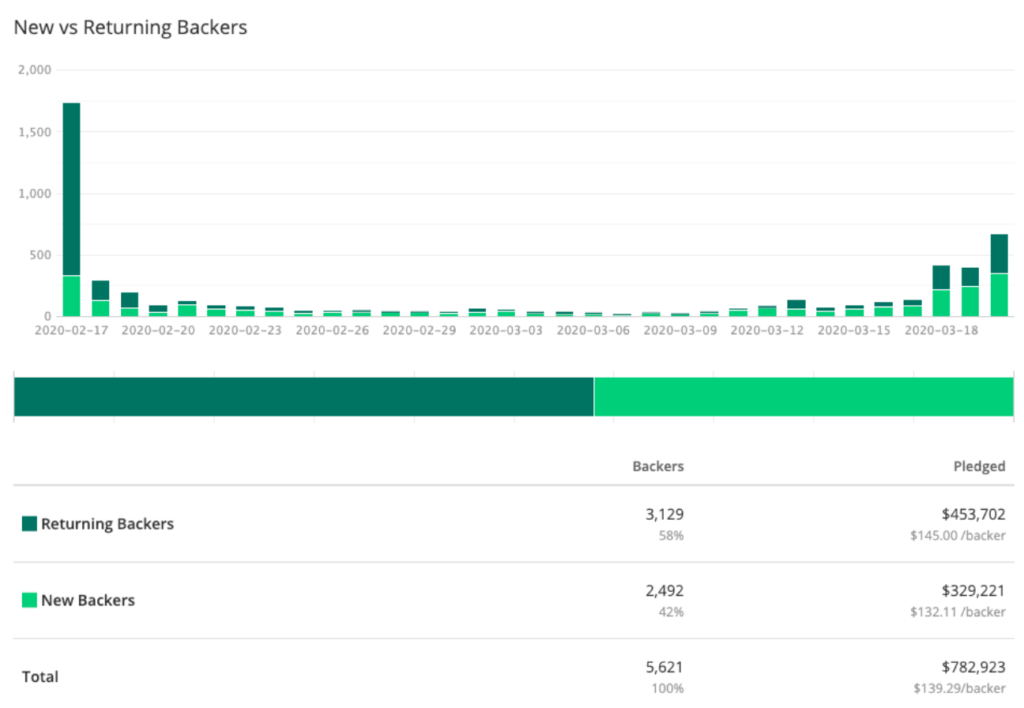
Take what you’ve learned about your audience to create custom messages to drum up excitement and secure early pledge commitments. If you’ve consistently engaged this audience in the days leading up to your launch, there shouldn’t be any surprises when it comes to your day-one performance.
ComixTribe publisher Tyler James has managed 16 successful Kickstarter projects. He tried Launch for his latest project, Counting, Colors & Cthulu, making use of the platform’s email templates and landing page feature to get backers to commit to backing on day one.
“What’s cool about this is that [Launch] actually creates an automatic pre-launch page that you can send backers to that let’s them click a button that says they’re in. Then it tracks how many backers from the audience that you sent it to actually click that button,” James says. “It’s great to get micro-conversions before you ever launch your Kickstarter project.”
In the first three days, Launch generated an 81x return on investment for James, and 205 of the 359 people who pre-committed to backing had already pledged.
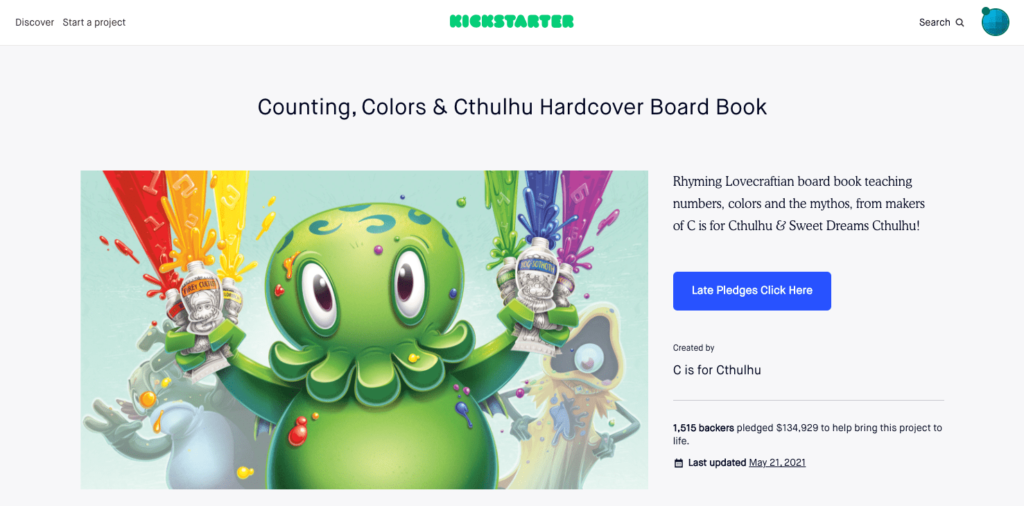
Getting started with BackerKit Launch
Who should use it? Anyone who is ready to start building their email list or who has an email list of fans. Launch is especially powerful for creators who’ve run successful campaigns.
When to use it: Before or after your project launches, up until it ends.
When to sign up: As soon as you have an upcoming project and are ready to let your community know about what you’re working on.
Challenge #2: Finding new backers

After you’ve had a strong launch, you’ll want to keep that momentum going, and bring in more backers. This means you’ll need to extend your reach beyond your own community and start connecting with a larger audience. But how do you build your audience? And with a long to-do list and budget concerns, how do you attract those new backers in the most cost and time-efficient manner possible?
Organic — or unpaid marketing — like social media and email promotion should be the foundation of your outreach strategy. You’ll maximize your budget if you first put the time into that grassroots relationship-building and promotion. Once you’ve had success with organic marketing, and you’re seeing conversions that you can track to your efforts, you can add some fuel to the fire and ensure your campaign reaches its full potential with paid marketing.
Drive pledges to your live campaign with advertising designed for crowdfunding using BackerKit Marketing
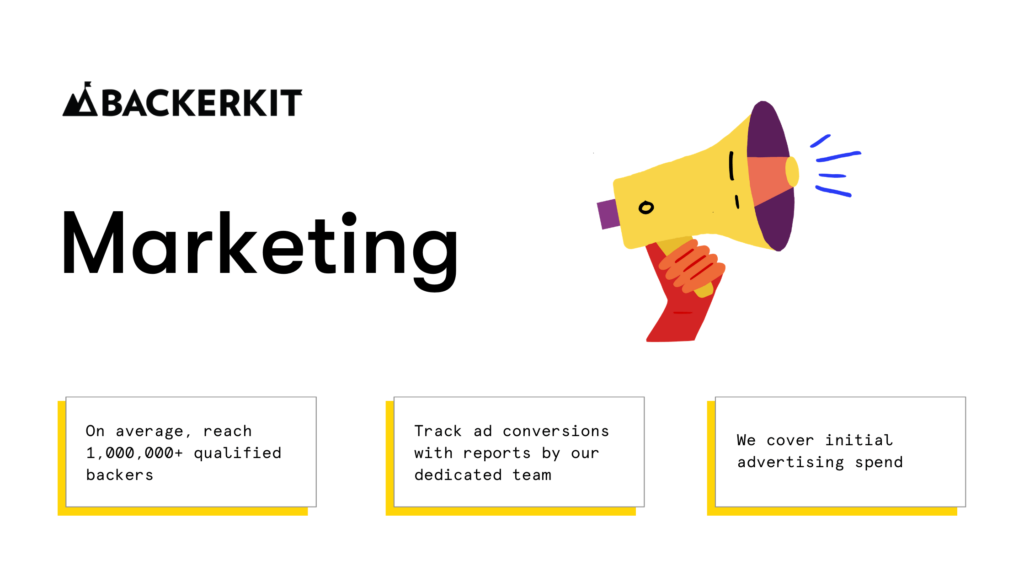
BackerKit Marketing is highly-targeted Facebook advertising designed for crowdfunding and run by a team of experts. With a database of more than 18 million backers, we help connect you with people who’ve supported projects like yours in the past and are more likely to pledge to your campaign. BackerKit covers the initial ad spend to maximize your funding potential, so you can scale without going over budget. Here’s what you can expect:
1. Connect with your target audience
It is possible to run Facebook Ads on your own. In fact, we encourage crowdfunding creators to run their own ad campaigns before reaching out to us to see what kind of return on ad spend (ROAS) they see. However, on your own you won’t be able to achieve the level of targeting you can with a service like BackerKit.
“You make an educated guess that males ages 25–42 living in these six US cities and with an interest in tabletop games are going to be the people interested in your tabletop campaign. Your backers probably are a subset of that group,” says BackerKit Sales Operations Manager Robert Wickham. “But you’re also paying Facebook to show your campaign to people who aren’t interested, which drives up your costs without giving you the results you’re looking for.”
GravGrip’s Kevin Thomas did well marketing on his own, but BackerKit’s targeting capabilities took his campaign to the next level.
“I was already off to a good start at around $133K. I recall being funded using just a few Facebook Ads I set up and my pre-marketing email list. The second BackerKit ads went live, we saw insane ROAS! It was over 10x for a few days,” Thomas says.
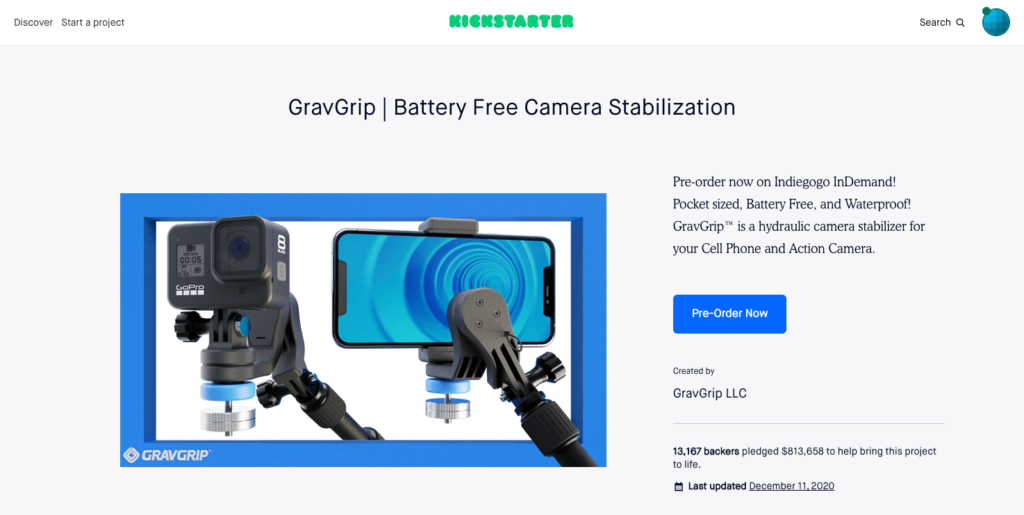
2. BackerKit Marketing won’t save a failing campaign
If your campaign is trending to fail, BackerKit Marketing isn’t going to turn that around. Our marketing services should only be used to amplify the promotion that you’ve already done. We want you to use your money wisely, so we have very specific qualifying criteria. Generally speaking, you’re most likely to be a good fit for BackerKit Marketing if:
- You know at least 500 people will show up to your page organically.
- Your margins are strong enough to support a commission on each sale and the cost of ads.
- Your category has broad appeal.
Apply for BackerKit Marketing to have your project reviewed by our team.
Getting started with BackerKit Marketing
Who should use it? It’s best for projects that would be on course to exceed funding goals. You must be a BackerKit Pledge Manager customer to use Marketing.
When to use it: Once your project is live.
When to sign up: The best time to reach out to our team is 1-3 months before launch. However, we can drive great returns mid-campaign, so you can still get in touch if you’ve already launched.
Challenge #3: Staying organized post-campaign and keeping backers happy
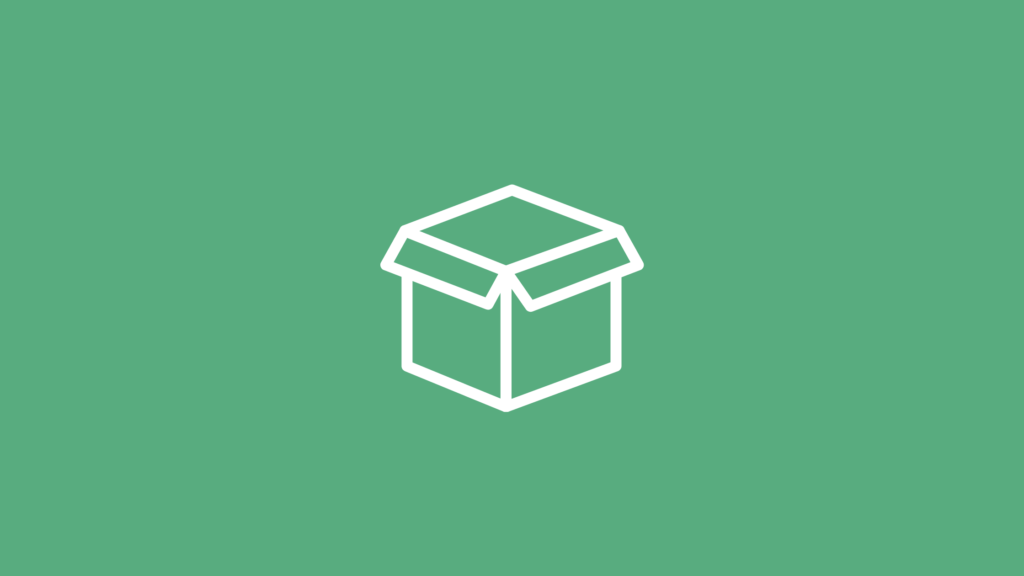
Once your project is finally funded, you’ll have to send out surveys to collect backer data and ship out rewards. A project with a smaller number of backers may be able to handle this part of the process on their own, managing all the data through spreadsheets. However, as your project scales and your funding goal and backer count increase, things get more challenging. You could potentially have mountains of information to sort through once you head into the fulfillment phase.
Raise additional funds, reach new backers, and manage orders with BackerKit Pledge Manager
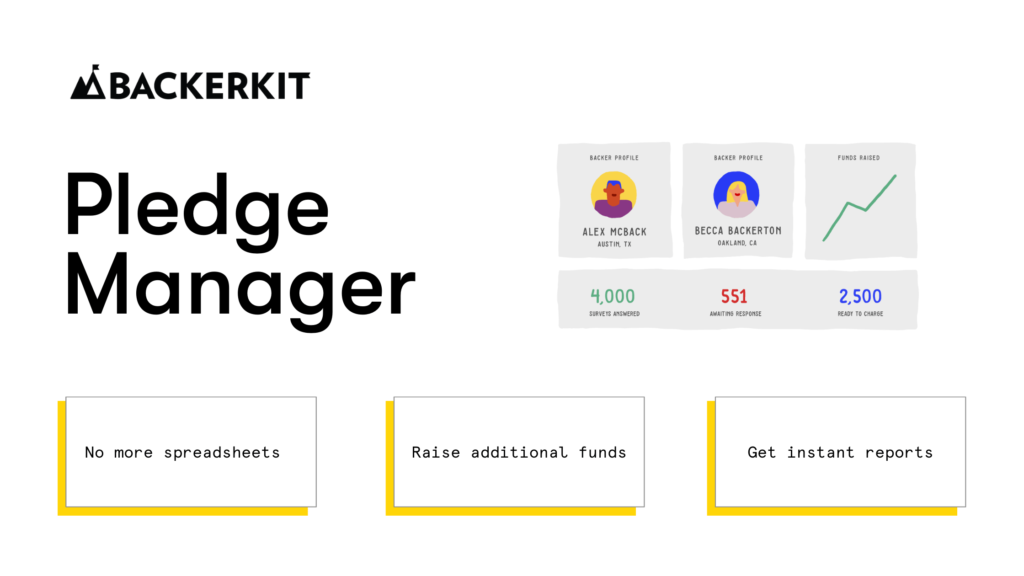
BackerKit Pledge Manager streamlines everything you’ll have to do after your campaign, helps you stay organized, and automates essential fulfillment tasks. You’ll use BackerKit to send out surveys to your backers. All of that information will be collected and visible in one convenient place.
If you have a lot of variations of the items you’re offering backers post-campaign (such as T-shirts that come in a variety of colors and sizes), you’ll have the unique ability to set up stock keeping units or SKUs (a short, unique identifier assigned to each individual item you provide backers) in BackerKit. The Item Generator makes the ordering process easier for backers, generates accurate counts for manufacturing, and streamlines fulfillment.
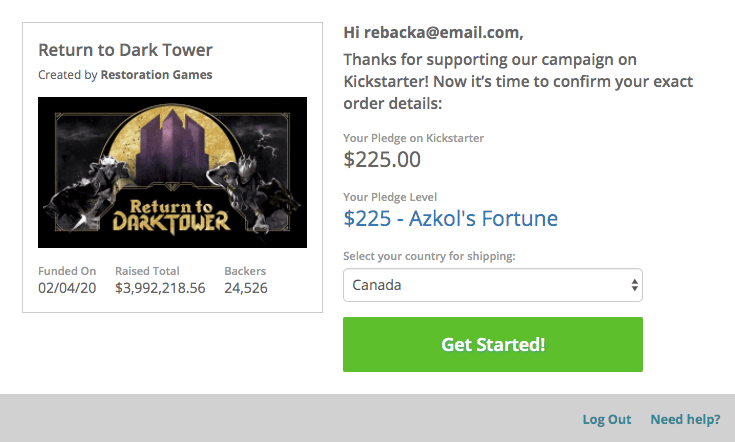
With Pledge Manager, you’ll be able to find individual backers, deal with special requests, and segment your audience (in case there is a specific action that you only want to apply to a certain group of backers).
After the GravGrip Kickstarter campaign ended, Thomas says that BackerKit boosted his efficiency.
“I would say that BackerKit Pledge Manager saves me 2-4 hours a day. The [number] of questions that require looking up a user and exactly what they ordered came in by the hour. BackerKit makes this process extremely easy,” he says.
You’ll also be processing orders through the Pledge Manager. We directly integrate with 3PL (third-party logistics) providers like Shopify and Easyship, making it easy to export orders to your fulfillment partner. Here are a few more features that will help you have a strong finish to your campaign:
1. Earn more with add-ons and pre-orders
You can continue raising money after your campaign in BackerKit through add-ons and pre-orders (or late pledges). Add-ons are items that backers can purchase in addition to what they’re receiving through their pledge. A pre-order store allows you to offer people who missed the opportunity to pledge to your campaign another chance to join in on the fun. Both of these features allow you to have the biggest campaign possible.
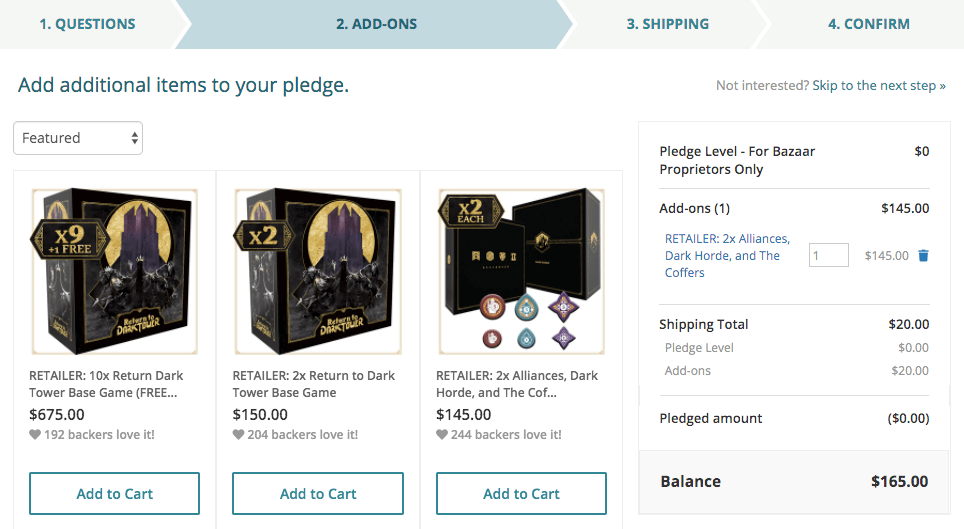
2. Get support for you and your backers
As prepared as you may be, you can’t anticipate all of the challenges you’ll face during fulfillment. From answering backer questions to dealing with international payment processing, there will inevitably be issues that you may not have the expertise or time to manage promptly. As your partner, the BackerKit team is prepared to help. With Backer Support, backer emails go directly to our expert support team who will keep your inbox under control by resolving 90% of backer requests. If you’re struggling to set up add-ons or have fulfillment questions, our Success team is there to offer guidance.
Getting started with BackerKit Pledge Manager
Who should use it? Crowdfunding creators who have successfully funded.
When to use it: After you’ve funded.
When to sign up: Before or after you’ve launched.
Are you ready to launch your crowdfunding project? Download our crowdfunding checklist to see if you’re on track.
Preparing for your campaign
When planning your campaign, think about everything you’ll need from start to finish. You don’t want to be so hyper-focused on the idea of reaching your funding goal that you neglect to take the fundamental steps that will help you raise the money you’re looking for. If you don’t know what you’ll need, ask other creators and check out resources like the BackerKit blog and the BackerKit Community Newsletter to get tips on the do’s and don’ts of crowdfunding.
You’re going to have to develop a budget well before you actually launch your project. When you’re doing this, you’ll not only want to figure out the costs of things like manufacturing and the development of creative assets, but also the costs of the tools that will make your campaign more manageable.
Running a crowdfunding campaign can be overwhelming, whether you’re an experienced creator or you’re thinking about launching your first project. BackerKit Launch, BackerKit Marketing, and BackerKit Pledge Manager can add structure to your journey, help maximize every opportunity you have to raise funds, and make the whole process run smoothly. You’re a creator — you should be devoting your time to bringing your cool ideas into the world. BackerKit’s tools were designed to make it possible for you to focus on doing what you love. 